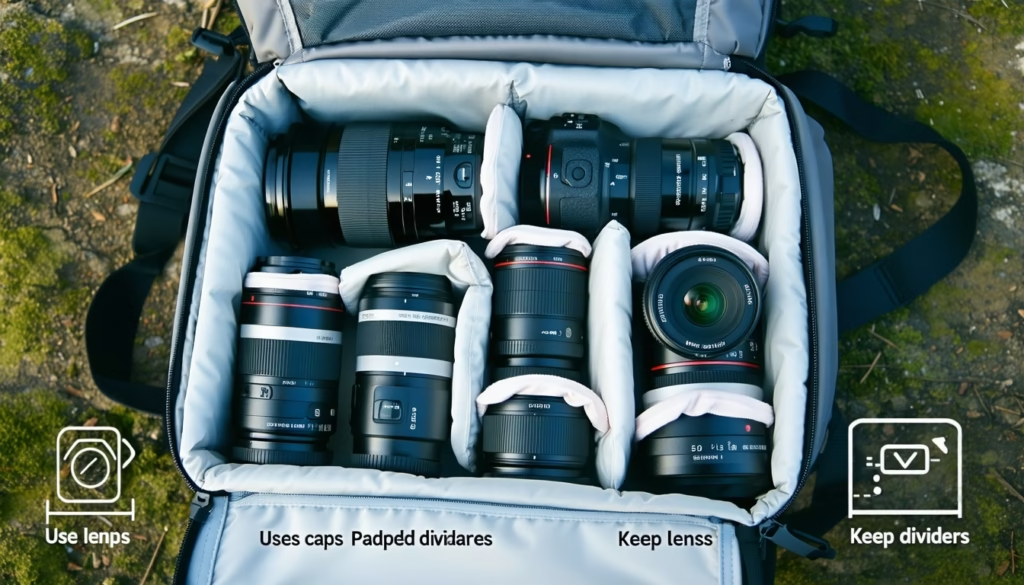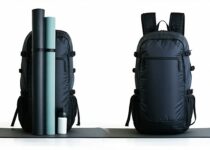Tips For Keeping Lenses Scratch-Free Inside A Backpack

You know the sinking feeling when you unzip your bag and spot a tiny scuff on your favorite lens, right? That’s why we’re sharing tips for keeping lenses scratch-free inside a backpack. In this guide you’ll learn how to pick the right backpack, pack like a pro, and use clever gear to keep your glass looking like new. By the end, you’ll feel confident stashing your lenses without worrying about dings or abrasions.
Select Quality Backpack
Not all backpacks are created equal when it comes to protecting fragile camera gear. Choosing a pack with the right features gives your lenses a head start against scratches.
Padding And Compartments
Look for thick foam walls and dedicated camera compartments. These sections cushion impacts and keep lenses from rubbing against other gear. Ideally, you want:
- Adjustable padded dividers to customize each slot
- Reinforced side panels to absorb knocks
- Soft lining (microfiber or fleece) to reduce friction
When shopping, check out essential features every photographer should want in a backpack for a deep dive into must-have specs.
Scratch-Resistant Interiors
Some packs include specialized scratch-resistant linings or removable insert shells. These materials feel almost velvety, letting lenses slide in without catching on rough fabric. If your pack doesn’t offer this, consider adding a scratch-free liner or use a separate protective case inside.
Choose Padded Lens Cases
Even in a cushioned backpack, it’s smart to give each lens its own padded home. A dedicated case adds an extra buffer against bumps.
Hard Cases vs Soft Cases
Both case types have pros and cons. Here’s a quick comparison:
| Case Type | Protection Level | Weight | Customizable Dividers |
|---|---|---|---|
| Hard | High | Medium | Limited |
| Soft | Medium | Low | Highly adaptable |
Hard cases shield against crush damage, while soft pouches fit odd shapes and pack down flat. Want more on this topic? See our camera backpack vs. hard case: which is better breakdown.
Customizable Dividers
Soft cases often come with hook-and-loop dividers so you can create snug compartments. Trim and rearrange them to match your lens sizes. Filling every gap ensures lenses don’t shift when you’re on the move.
Pack Lenses Correctly
Even the best cases need proper handling. How you orient and secure each lens inside its pouch or slot makes a big difference.
Align Vertically
Stand lenses upright (mount end down) to distribute weight evenly. Laying them flat can let the weight press on delicate glass or focus rings. Think of each lens as a little tower that wants to stay standing.
Secure With Caps And Cloth
Always seal front and rear caps before packing. An extra lens cloth wrapped around the barrel adds a soft barrier against dividers or neighboring gear. Keep microfiber cleaning cloths on hand for quick polish-ups before you shoot.
Optimize Backpack Layout
A smart layout reduces rummaging, so you avoid unnecessary movement that can lead to scratches.
Modular Insert Benefits
Using a modular insert lets you design each compartment exactly where you need it. You can create separate zones for bodies, bodies with lenses attached, and spare lenses. This approach stops you from sliding equipment around in one giant pocket.
Layering Strategy
Work in layers to protect your lenses:
- Place heavier items (like camera bodies) on the bottom layer
- Add a padded divider or cloth layer
- Nest smaller lenses in the middle
- Use top compartments for cables and filters
This sandwich method keeps glass away from hard edges and disperses any pressure.
Quick-Access Side Doors
If your pack has side access panels, you can grab your main lens without pulling everything out. Minimizing how often you shuffle contents helps prevent accidental scuffs. Learn more about smart layouts in our guide to the best camera backpack layouts for fast access.
Stabilize Lenses Inside
Preventing movement is key. Even slight shifts can cause lenses to bang into each other when you walk or run.
Avoid Movement
Use snug compartments or lens pouches that match each lens’s dimensions. Gaps equal chances for lenses to collide. If your insert has leftover space, tuck in a small object—like a rolled-up microfiber cloth—to take up slack.
Fill Gaps With Padding
For odd-shaped lenses or telephoto zooms, foam cubes or bubble wrap can fill irregular spaces. Just avoid overstuffing, which can warp delicate barrels. Aim for a firm but gentle hold.
Use Additional Protective Gear
Beyond cases and dividers, a few extras can keep moisture and grit from scratching your glass.
Lens Pouches And Sleeves
Neoprene or padded sleeves slide over each lens for an extra layer. They compress nicely and can ride loose in a general compartment if you’re short on space. Some pros carry thin neoprene pouches for emergency re-wrapping.
Silica Gel Packs
Scratches often start when sand or grit rubs lenses together. Tuck silica gel packs in each section to absorb moisture, which helps keep debris from sticking. Replace packs regularly, as they lose effectiveness over time.
Handle Backpack Safely
It’s not just packing, but how you carry and load your bag that impacts lens safety.
Avoid Sharp Objects
Keys, pens, or tools in the same pocket can pierce a lens cap or scratch the body. Use zipped pouches or dedicated pockets to isolate sharp items. For multi-tool fans, consider a small case of its own.
Mindful Loading And Unloading
When you set your bag down, place it on a clean, flat surface. Avoid gravel, sharp stones, or uneven ground that could force grit inside. Unzip compartments slowly so lenses don’t fall or catch on zippers.
Maintain Your Gear
A little upkeep goes a long way in preventing scratches over time.
Clean Backpack Interior
Empty and vacuum your pack every few shoots. Remove dust, dirt, and any loose debris hiding in corners. A lint roller works wonders on fuzzy interior lining.
Inspect And Rotate Lenses
After each trip, inspect lens barrels, caps, and cases for wear. Swap lenses around so no single piece gets all the jostling. Regular rotation balances use and reduces the odds of repeated abrasion on one lens.
Frequently Asked Questions
How often should I replace padded dividers?
It depends on wear, but inspect them every six months. If edges look frayed or foam feels compressed, swap in new dividers to maintain snug fits.
Can I use my backpack’s laptop sleeve for lenses?
Laptop sleeves are padded but not designed for round shapes. They may let lenses shift, increasing scratch risk. Stick to camera inserts or lens pouches.
Are lens wraps better than hard cases?
Wraps and hard cases serve different needs. Wraps are lightweight, great for quick stashing, while hard cases excel at crush protection. Many photographers use wraps inside hard cases for double protection.
Should I remove filters before packing?
Keeping filters on prevents dust from entering the lens, but cheap filters can scratch front elements. Use high-quality UV or clear filters and clean them regularly if you plan to pack with them attached.
Is it okay to pack lenses with attached hoods?
Lens hoods add bulk and can press into your backpack lining. If space allows, attach hoods and use a roomy slot. Otherwise, pack lids and hoods separately to avoid misalignment.
Can temperature changes cause lens scratches?
Rapid temperature shifts can create condensation, which attracts dust. Let lenses acclimate by sealing them in a zip-lock bag before moving from cold to warm environments. This prevents moisture buildup inside.
Conclusion
Protecting your lenses from scratches starts with the right backpack, cases, and organization system. By combining padded inserts, smart packing strategies, and routine maintenance, you’ll keep your glass in top shape trip after trip.
Try one tip today—maybe adding a scratch-resistant liner or reorganizing your layout—and notice how much more secure your lenses feel. Safe shooting out there, and may your next frame be perfectly sharp.


